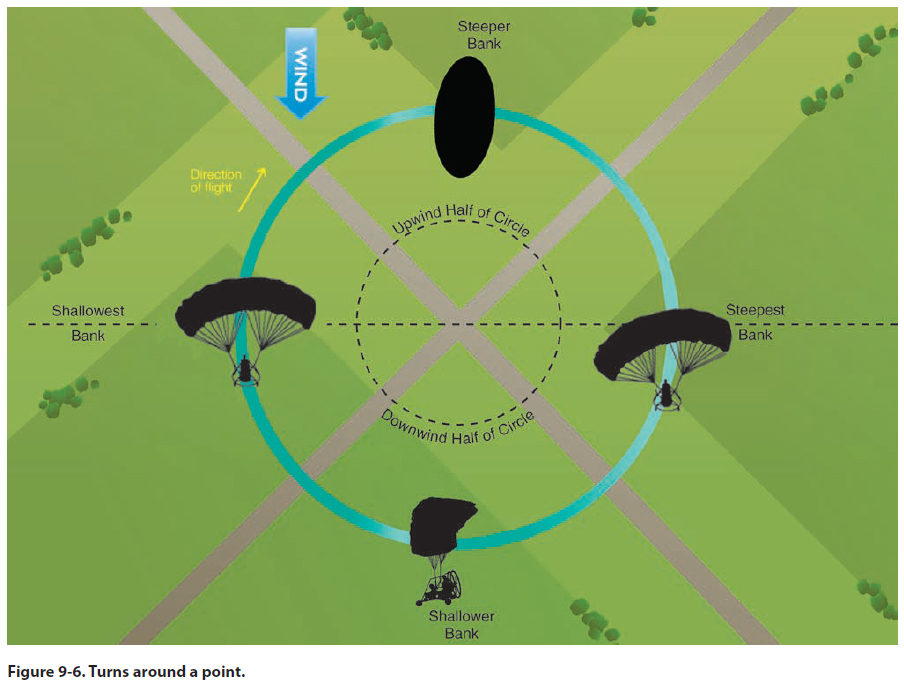Chapter 9 — Ground Reference Maneuvers
Turns Around a Point
As a training maneuver turns around a point is a logical
extension of the principles involved in the performance
of S-turns across a road. Its purposes as a
training maneuver are:
• To further perfect turning technique.
• To perfect the ability to subconsciously control
the powered parachute while dividing attention
between the flightpath and ground references.
• To teach the student that the radius of a turn is a
distance which is affected by the degree of bank
used when turning with relation to a definite
object.
• To develop a keen perception of altitude.
• To perfect the ability to correct for wind drift
while in turns.
In turns around a point, the powered parachute is
flown in a complete circle of uniform radii or distance
from a prominent ground reference point while maintaining
a constant altitude; do not go lower than 200
feet.
The factors and principles of drift correction that are
involved in S-turns are also applicable in this maneuver.
As in other ground track maneuvers, a constant
radius around a point will, if any wind exists, require
a constantly changing angle of bank and wind correction
angles. The closer the powered parachute is to a
direct downwind heading where the groundspeed is
greatest, the steeper the bank and the faster the rate
of turn required to establish the proper wind correction
angle. The more nearly it is to a direct upwind
heading where the groundspeed is least, the shallower
the bank and the slower the rate of turn required to
establish the proper wind correction angle. It follows,
then, that throughout the maneuver the bank and rate
of turn must be gradually varied in proportion to the
groundspeed.
The point selected for turns around a point should
be prominent, easily distinguished by the pilot,
and yet small enough to present precise reference.
[Figure 9-6] Isolated trees, crossroads, or other similar
small landmarks are usually suitable.

To enter turns around a point, the powered parachute
should be flown on a downwind heading to one side
of the selected point at a distance equal to the desired
radius of turn.
When any significant wind exists, it will be necessary
to roll into the initial bank at a rapid rate so that the
steepest bank is attained abeam of the point when the powered parachute is headed directly downwind. By entering
the maneuver while heading directly downwind,
the steepest bank can be attained immediately. Thereafter,
the bank is shallowed gradually until the point is
reached where the powered parachute is headed directly
upwind. At this point, the bank should be gradually
steepened until the steepest bank is again attained when
heading downwind at the initial point of entry.
Just as S-turns require that the powered parachute be
turned into the wind in addition to varying the bank,
so do turns around a point. During the downwind half
of the circle, the powered parachute’s nose is progressively
turned toward the inside of the circle; during the
upwind half, the nose is progressively turned toward
the outside. The downwind half of the turn around
the point may be compared to the downwind side of
the S-turn across a road; the upwind half of the turn
around a point may be compared to the upwind side
of the S-turn across a road.
As the pilot becomes experienced in performing turns
around a point and has a good understanding of the
effects of wind drift and varying of the bank angle
and wind correction angle as required, entry into the maneuver may be from any point. When entering the
maneuver at a point other than downwind, however,
the radius of the turn should be carefully selected, taking
into account the wind velocity and groundspeed
so that an excessive bank is not required later on to
maintain the proper ground track. The flight instructor
should place particular emphasis on the effect of an
incorrect initial bank.
Common errors in the performance of turns around a
point are:
• Failure to adequately clear the area.
• Failure to establish appropriate bank on entry.
• Failure to recognize wind drift.
• Excessive bank and/or inadequate wind
correction angle on the downwind side of the
circle resulting in drift towards the reference
point.
• Inadequate bank angle and/or excessive wind
correction angle on the upwind side of the circle
resulting in drift away from the reference point.
• Gaining or losing altitude.
• Inadequate visual lookout for other aircraft.
• Inability to direct attention outside the powered
parachute while maintaining precise powered
parachute control.
|

